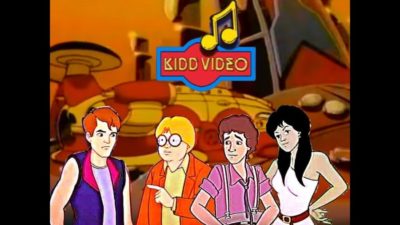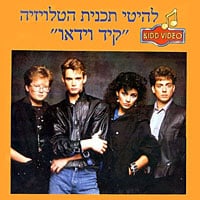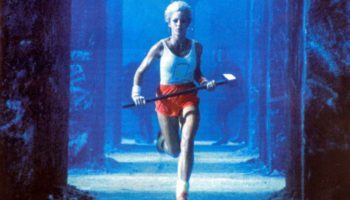
What do you get when you take all the great things of the 80s; music, music videos, cartoons, Saturday mornings, and put them all together? You’ve got Kidd Video
Kidd Video was a live-action/cartoon series airing on Saturday mornings. It featured Kidd Video and his band that were transported to the “flipside” by the Master Blaster. It aired on NBC from 1984 to 1985 before being picked up for syndication by CBS.
You know how there are certain things buried away in your memory that you definitely remember but just can’t recall? Kidd Video is one of those things for me. I had fully embraced it at the time and it made a significant impact on me, but it’s something I had completely forgotten about until just recently hence writing this article.
It’s amazing how something can just disappear from your thoughts like Kidd Video did but if you look at the overwhelming amount of content that we were bombarded with in the 80s, it makes sense. The usual things like G.I. Joe, Transformers, He-Man etc fully embedded themselves into our brains, so they weren’t going anywhere. A show like Kidd Video, however, only took a small chunk and then we moved on.
It’s been cool to look back on this seemingly throwaway show and see what really made it tick. Music videos on Saturday mornings? This is a full look back at Kidd Video.
What Was Kidd Video?
So you just have to watch that intro/theme song to get the rundown of the premise of Kidd Video. This was a time when theme songs for shows and cartoons basically gave you the gist of what the whole show was about so you could jump into each episode fresh. It’s kind of like a sitcom in that you don’t need to really worry about story arcs or continuity and each show exists as a standalone episode.
But here’s the whole scoop:
Kidd Video is an actual guy, and he has a band that’s depicted by live-action characters featured in the first part of the intro. Then the animated “Master Blaster” character shows up and transports them to his home dimension called “The Flipside” – I’m wondering if this dimension exists alongside Dimension X somehow.
So Master Blaster is using them, of all bands, as his musical slaves and the eventually get rescued by a fairy/Tinkerbell sort of creature named Glitter. They would spend most episodes trying to either get themselves home or to help free other people that Master Blaster had enslaved.
Who Were The Main Characters?
So the actors featured in the first part of the intro would also be the ones to provide the voices and sing the actual songs, for the show. Let’s take a look!
Kidd Video – He was played by Bryan Scott who was the lead guitarist and singer. Scott appeared in that movie “Dead Presidents”.
Carla – played by Gabrielle Bennet was the drummer and only female on the show. She is now known as Gabriela Nelson and used to perform in USO shows with the legendary Bob Hope
Whiz – played by Robbie Rist who might be one of the most important actors when it comes to all things Nostalgia. Not only was he cousin Oliver on the Brady Bunch but he was the voice of Michaelangelo in the first Teenage Mutant Ninja Turtles movie. He also directed and wrote music for the Sharknando movie which is just awesome.
Ash – He was the keyboardist and played by Steve Alterman. He appeared on Eight is Enough and also Knight Rider and even started a band with Robbie Rist called “The Beat Society”. He’s also done a ton of pretty sweet voice work for things like:
- How to Train Your Dragon
- Ice Age
- Kung Fu Panda
- Madagascar 2
- Lilo and Stitch
- Final Fantasy
- Avatar
- Mission Impossible 2
- Big Mommas House
- Scary Movie
- Baywatch
- The X Files
Glitter – was voiced by Cathy Cavadini. Glitter would gain strength as she sneezes and Cavadini was the original voice of Blossom in the Power Puff Girls, Tanya in “Fivel Goes West” and has ton voices in a TON of epic cartoons including:
- Cars 3
- Finding Dory
- Garfield Gets Real
- The Grinch
- The Lion King
- My Little Pony
- Pound Puppies: The Legend Of Big Paw
- Ready Player One (she was the voice over the PA at IOI)
- Darkwing Duck
Honestly, there’s a ton more – just check her Wikipedia page, but she has won Emmys for sound design on the X Files and won a White House Project Epic Award that is given to projects that promote women leadership.
Master Blaster – He was meant to represent a corrupt music manager and was played by Peter Renaday who has done voices in pretty much every cartoon and video game you can imagine. Here are some highlights:
- He was the voice of Splinter in the Teenage Mutant Ninja Turtles cartoon
- Animaniacs
- Duck Tales
- G.I. Joe
- Justice league
- Scooby-Doo and Scrappy-Doo
- Transformers
- The Real Ghostbusters
You’ve got a real all-star voice cast here and some other characters on the show included Toolbot and the Copy Cats who were the minions of Master Blaster
How MTV led To The Development Of Kidd Video
The idea of Kidd Video was to capitalize on the success of MTV and music videos and package this all up in a Saturday Morning cartoon. MTV was changing the way we consumed music, but it wasn’t necessarily for kids, Kidd Video would make kid-friendly content and the show would incorporate live-action music videos.
The entire premise of the show would be music based and they would incorporate more live-action sequences using current and popular songs that would serve as distractions to their enemies within the show.
To further capitalize on the MTV movement they would include popular fads and events to tie everything together. This is what I mean that Kidd Video was all the best things in the 80s rolled into one. Several shows would include the use of the popular “break dancing” that were popping up all over the place (popping up was my inadvertent attempt at a break dance joke). They also would include skateboarding and video games.
To tie things in even deeper to MTV the look, and style, of Kidd Video, was based on the more unique and surreal videos that they had been playing. Another big influence for the look of the show was modeled after the artwork of Roger Dean.
Dean was an English artist who created a lot of posters and album covers for bands in the 60s. He would continue to create posters and artwork for bands and concerts into the 70s and would also create covers for video games of the 80s. He created very moody style landscapes and this style would be used on album covers for bands like:
- Yes
- Asia
- Uriah Heep
I was obviously completely unaware of this as a kid but you can definitely see his influence through the animation of Kidd Video.
How Did All Of This Come Together?
It starts with two big production companies: DiC Entertainment and Saban Entertainment. DiC gave us shows like Inspector Gadget and the Littles, Sabban gave us Power Rangers, The Alf cartoon, Kissyfur (among a ton of other things) and partnered with Marvel.
The obvious idea here is getting music videos onto Saturday mornings and each episode was based around showcasing some sort of music video or performance. They also wanted to finish each episode with another music video that was to show that the band of Kidd Video was real and not just a fictionalized bunch of characters on TV.
But they were, so this was a weird combination of real life, cartoon, and parody. It’s like the Monkees but they would exist in our world and the fantasy cartoon world. If you can’t keep up with this, I don’t think a lot of kids at the time did either – they just wanted to watch something cool.
The show would capitalize on popular songs at the time (like the Mini Pops would) but would also feature original songs, some created by the actual cast members.
The Importance Of The Music
Since a lot of the focus of the show was on music, a composer named Shuki Levy would take on a lot of this responsibility. He wrote the awesome theme song (“Video to Radio”) and he also brought us some other iconic cartoon themes such as Inspector Gadget and He-Man and the Masters of the Universe. He was a pretty big deal in the 1980s cartoon theme song space creating music for a lot of other shows.
So the whole point of the show was to create situations where they could showcase the band singing popular songs. The end of the shows, as mentioned, would feature an original song and performance in a music video. I think their idea was that Kidd Video would be a huge crossover success and their music would hit the charts leading to album sales and tours.
And that did kind of happen, and we’ll get to it in a moment.
Capitalizing on all things music, the actors of Kidd Video would be part of a “We Are The World” campaign called “Kidds for Kids” which was a song and performance by UNICEF, used to raise money for starving kids in Africa. I don’t remember any of this and I’m not sure where something like this was broadcast at the time. But it featured 60 child stars including some big names of the day such as:
- Joey Lawrence
- Soleil Moon Frye
- Jason Bateman
- Todd Bridges
The Kidd Video actors carried the main vocals because I don’t think Willis had the best vocal range…
Breaking Free From North America

Those lofty dreams of hit records and tours happened for Kidd Video but in Israel. Shuki Levy and Saban Entertainment were originally from there so they wanted to share a true American act in their home country.
And it worked.
Kidd Video put out an album of original hits along with other merchandise including candy bars and even yogurt for some reason. They would also tour all around Isreal and for some reason, caught on there pretty well.
Besides the album, they would put out a children’s cassette that was an audio story on tape recorded in Hebrew. It would feature a few of their original songs but was primarily used as a way to further the story of Kidd Video. So you could listen to the cassette while eating their yogurt and laying on Kidd Video bed sheets (I didn’t mention that they released bed sheets too…).
The End Of The Show
So Kidd Video actually came out of the gate pretty hot when it first debuted. It was the number one new children’s show and third in the overall Saturday morning ratings which is HUGE.
The big problem they might not have anticipated is one that happens to all children’s based entertainment – the kids grow up. When you have a cartoon it means the characters are ageless and continue on forever pretty much.
When you deal with child actors everything changes; their look, their style, their attitudes, and personalities. So many shows have been victims to this over the years. Some like Full House was able to push through it and some were heavily affected – like Different Strokes.
In the second season of Kidd Video, one of the actors (they would never say who but I’m betting on Robbie Rist) lost so much weight that they would have to recreate the cartoon character. That meant having to go back and recreate all the model sheets that are used for the animation and this was very expensive at the time.
So then all the actors were going to keep growing and changing and it would cost a fortune to continuously recreate all the animation models year after year. The second season would catch up a bit in keeping the animated characters looking like their real-life counterparts, but it wasn’t sustainable.
One of the producers “joked” that he didn’t want the actors changing their hairstyles or getting any type of makeovers. Again, the idea was that they wanted them to be big in the real world with concerts and live appearances and they needed the cartoon to look just like them.
Final Thoughts On Kidd Video
I’m enamored with Kidd Video now. Not only is it something I forgot all about, but it’s amazing to learn more about everything that went behind it. It clearly wasn’t the success they were hoping for and the band didn’t become a household name – except to loyal viewers on Saturday mornings.
The other interesting thing is that it always signaled the end of cartoons each Saturday morning as the networks moved into more live-action programming, and Kidd Video was a way to bridge that gap. The producers had noted that they wanted Kidd Video to be the “Miami Vice” of Saturday Morning Television.
It’s an interesting phenomenon to look back on as, as it’s been pointed out by Toy Galaxy, this type of show could only have existed in the mid-80s. Getting a license for popular songs was more doable at the time and those licenses would have now expired a long time ago. So even if they wanted to somehow do a re-release of the show – not that many are even familiar with it – they wouldn’t have the rights to broadcast anything they did in the 80s meaning it’s pretty much a dead show.
Plus Disney owns everything put out by DiC so there’s that. So it kind of sucks its something we’ll never see, or probably ever see again. It represents the 80s very well though in a nice little snapshot where it was easier to get music rights and the closest thing you would get today are movies like Sing or Pitch Perfect.
There’s an awesome YouTube channel called Toolbot where you can watch most of the episodes, and the music videos too, so if this is the first you’re hearing of Kidd Video, or you’re looking back at something you loved, it still lives on.



